Analysis of Fiber Content and Orientation in Prefabricated Slab Elements Made of UHPFRC: Non-Destructive, Destructive, and CT Scanning Methods
Abstract
1. Introduction
2. Materials and Methods
2.1. Prefabricated Slabs
2.2. Non-Destructive Coil Quality Factor Measurements
2.3. Destructive Bending Experiments Setup
2.4. CT Fiber Scanning
3. Results and Discussion
3.1. Destructive Bending Tests
3.2. Non-Destructive Quality Factor Measurements
3.3. Correlation Analysis—Flexural Strength and Quality Factor
3.4. CT Scanner Images
4. Conclusions
- The quality factor measurements accurately evaluated fiber concentration and orientation, so the method can be used as a quality control principle in the prefabrication industry.
- The method is relatively simple and inexpensive to apply for quick quality control. However, more complex solutions (integrating into an automated production line, continuous scanning, finer scanning mesh, or adaptive measurement point selection) could be possible future headings if more detailed measuring data are desired.
- Both are comparative measurements. Fiber concentration values should be similar throughout the specimen.
- Fiber orientation is strongly dependent on the casting direction, as expected, and the quality factor values confirmed it.
- Measured quality factor values can be used to predict the overall mechanical behavior, especially in regard to identifying major material defects.
Author Contributions
Funding
Institutional Review Board Statement
Informed Consent Statement
Data Availability Statement
Conflicts of Interest
Appendix A
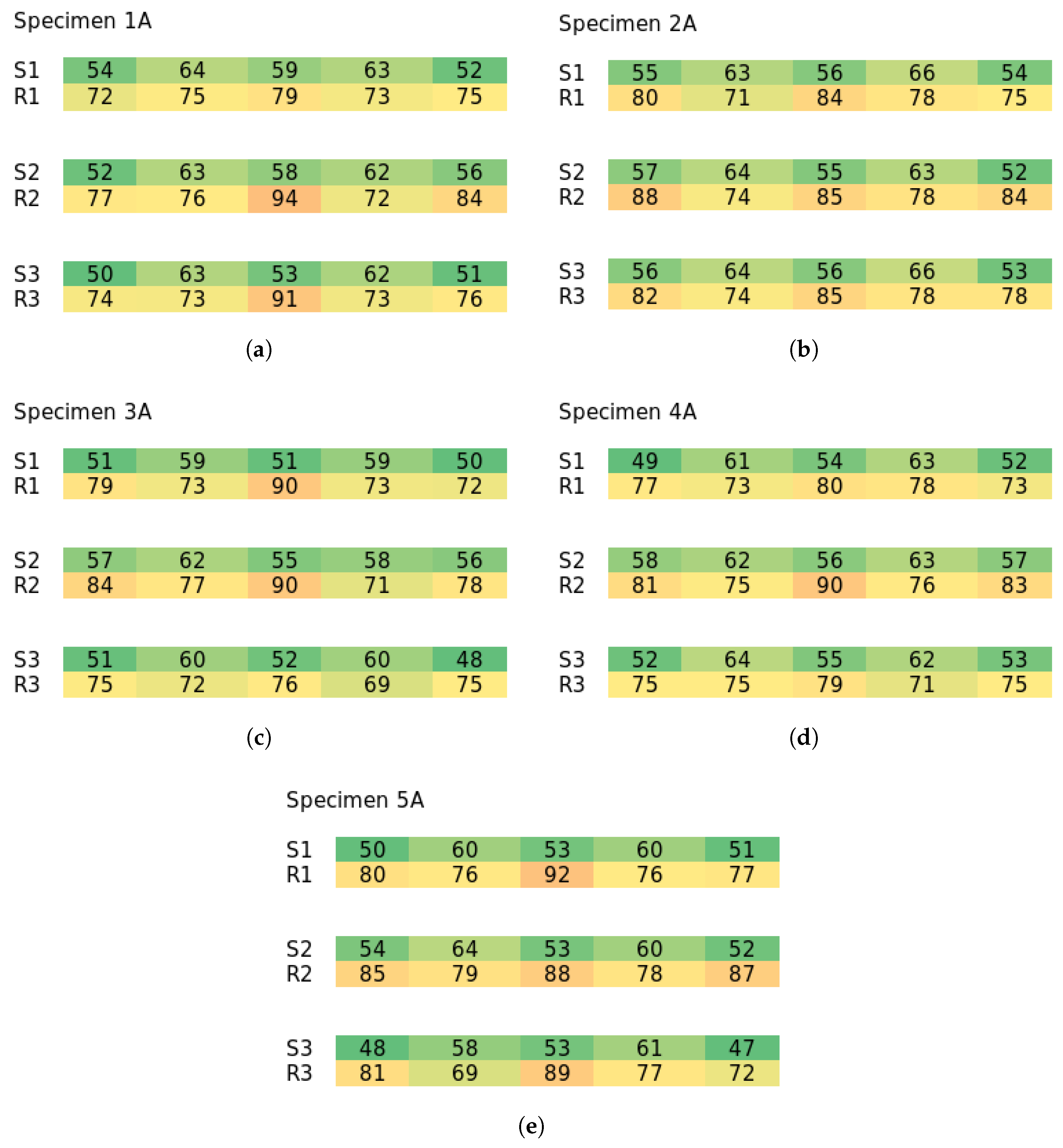
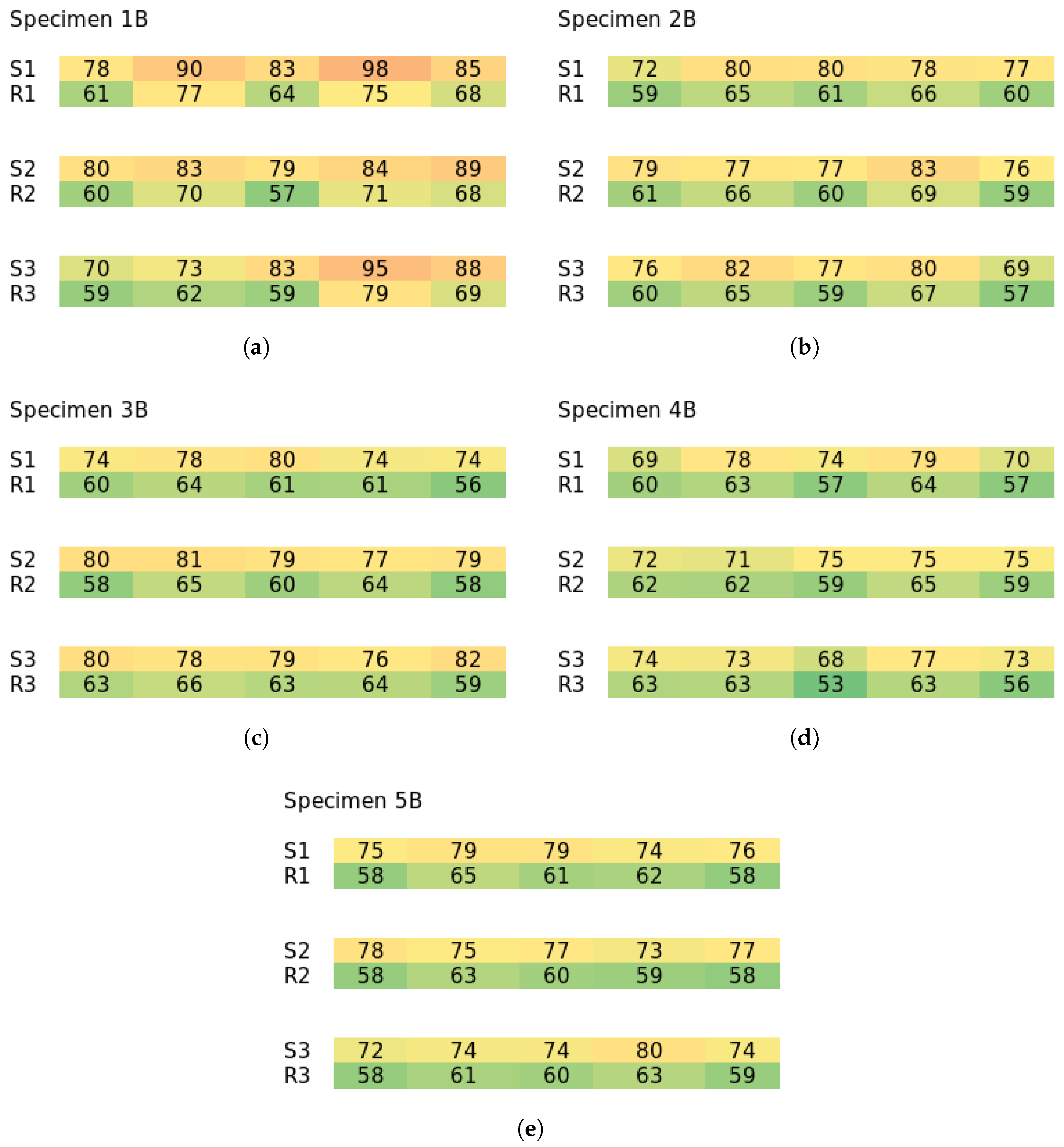
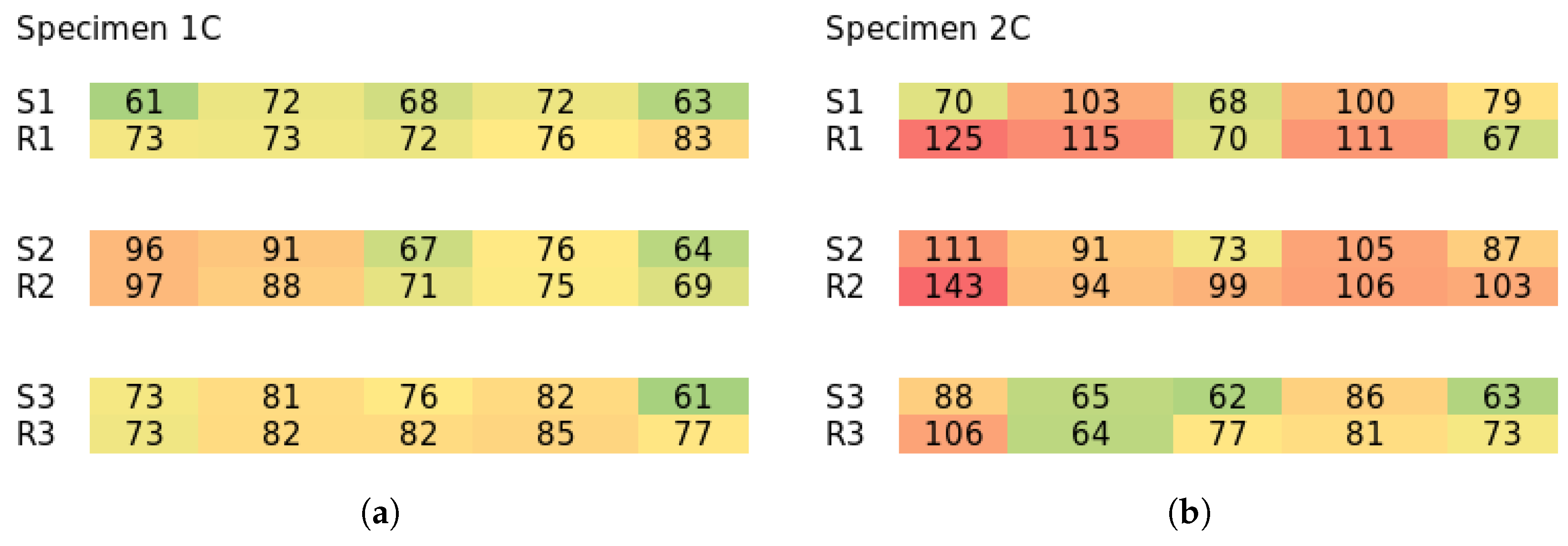
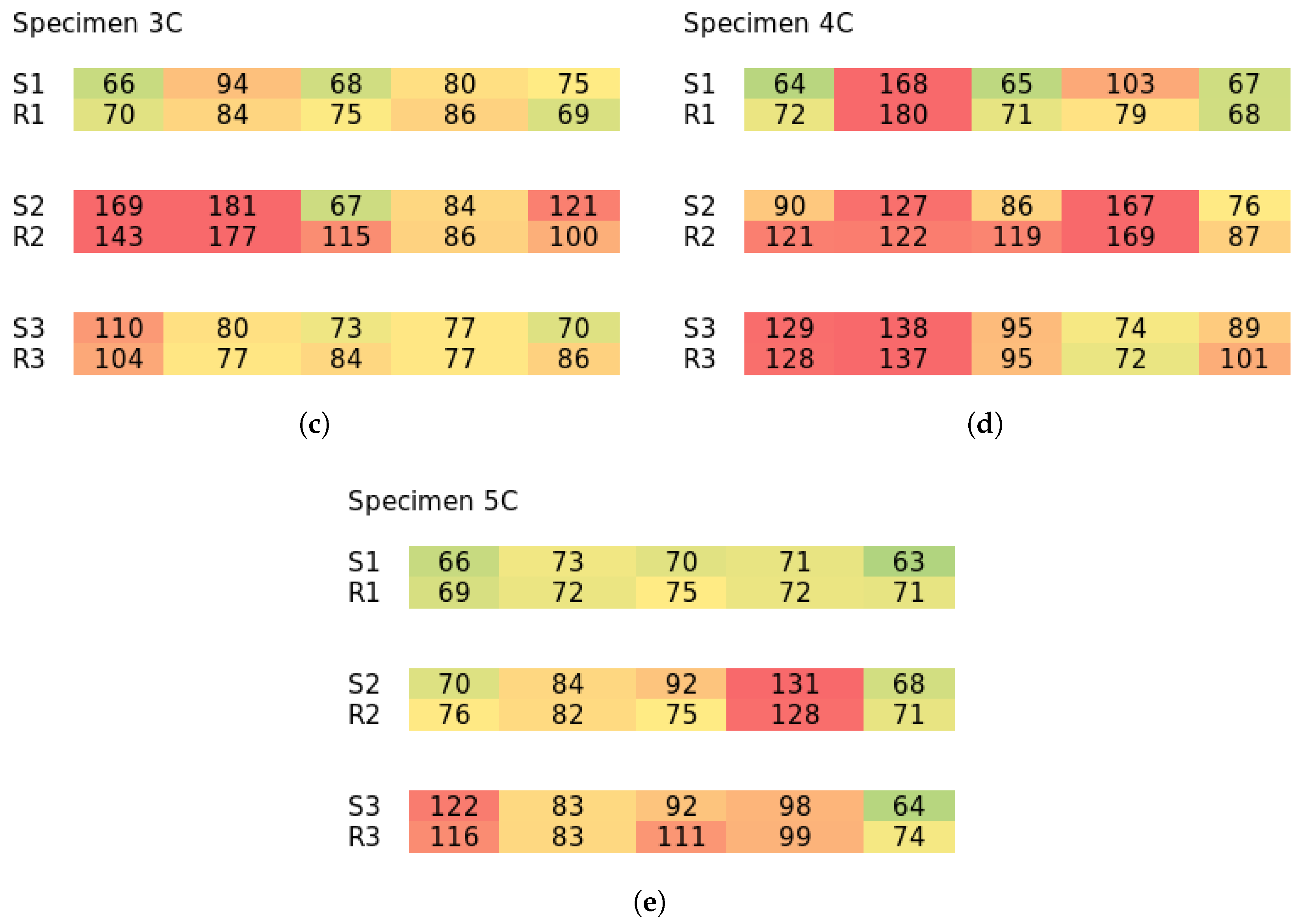
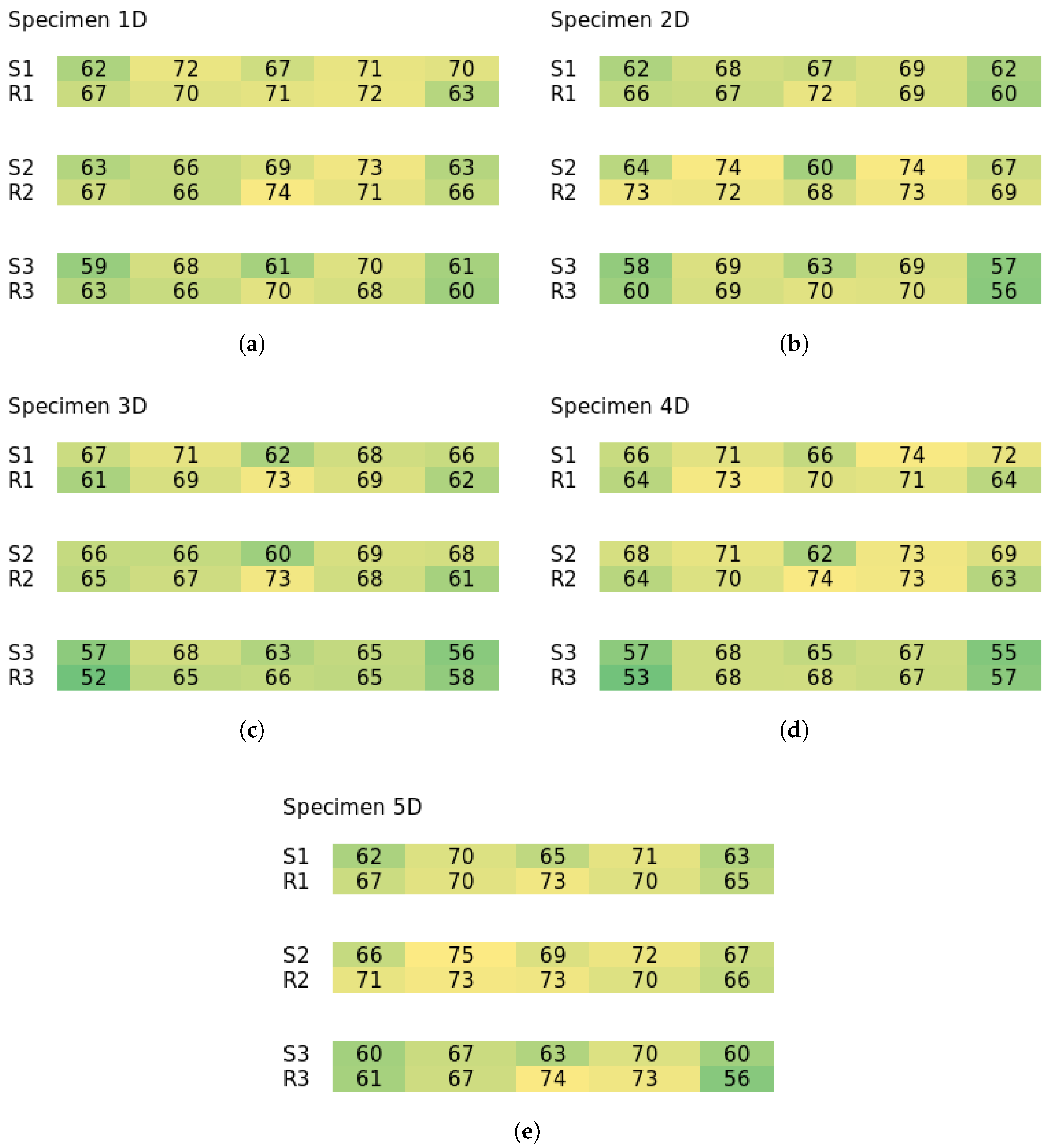
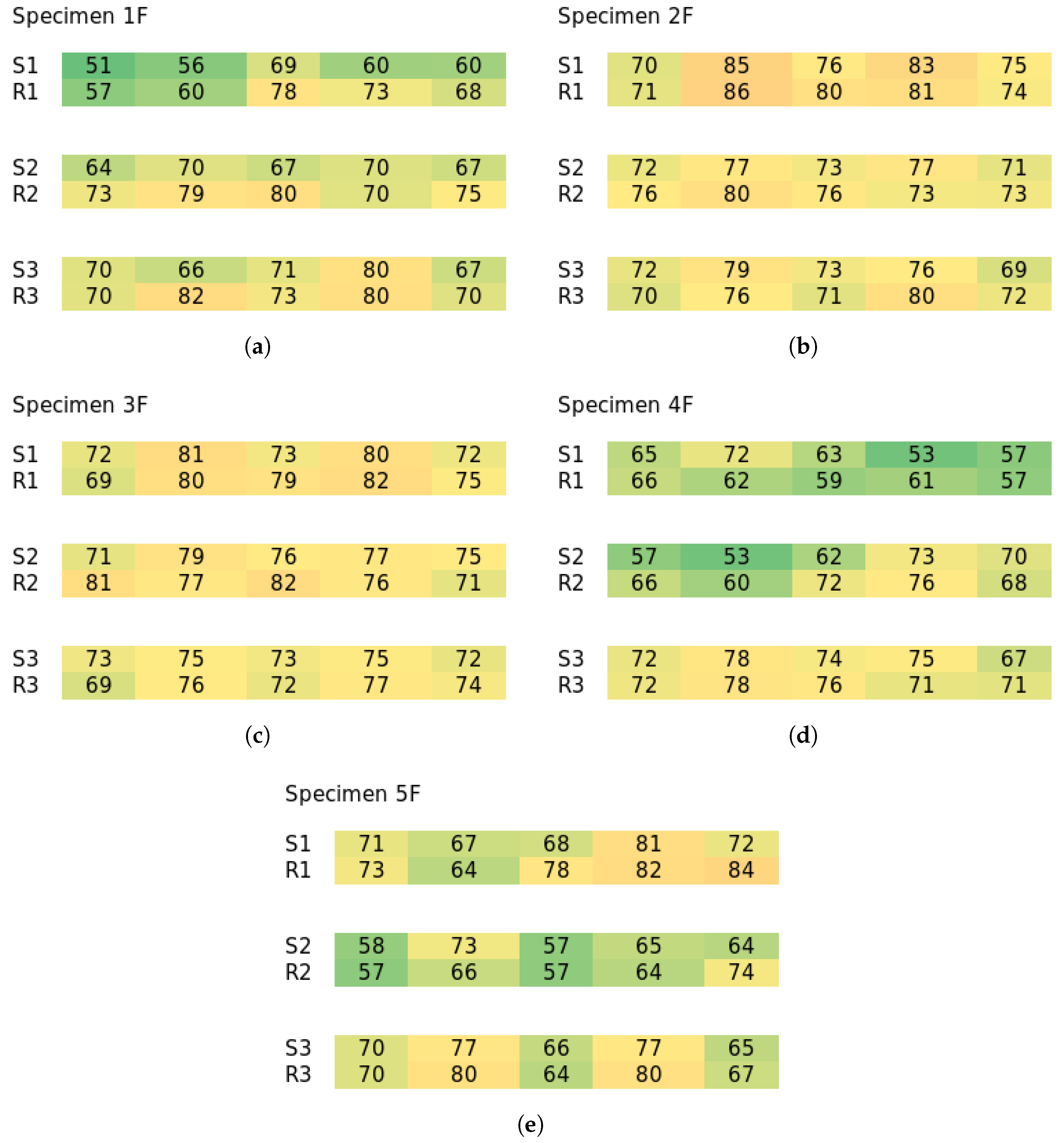
Appendix B
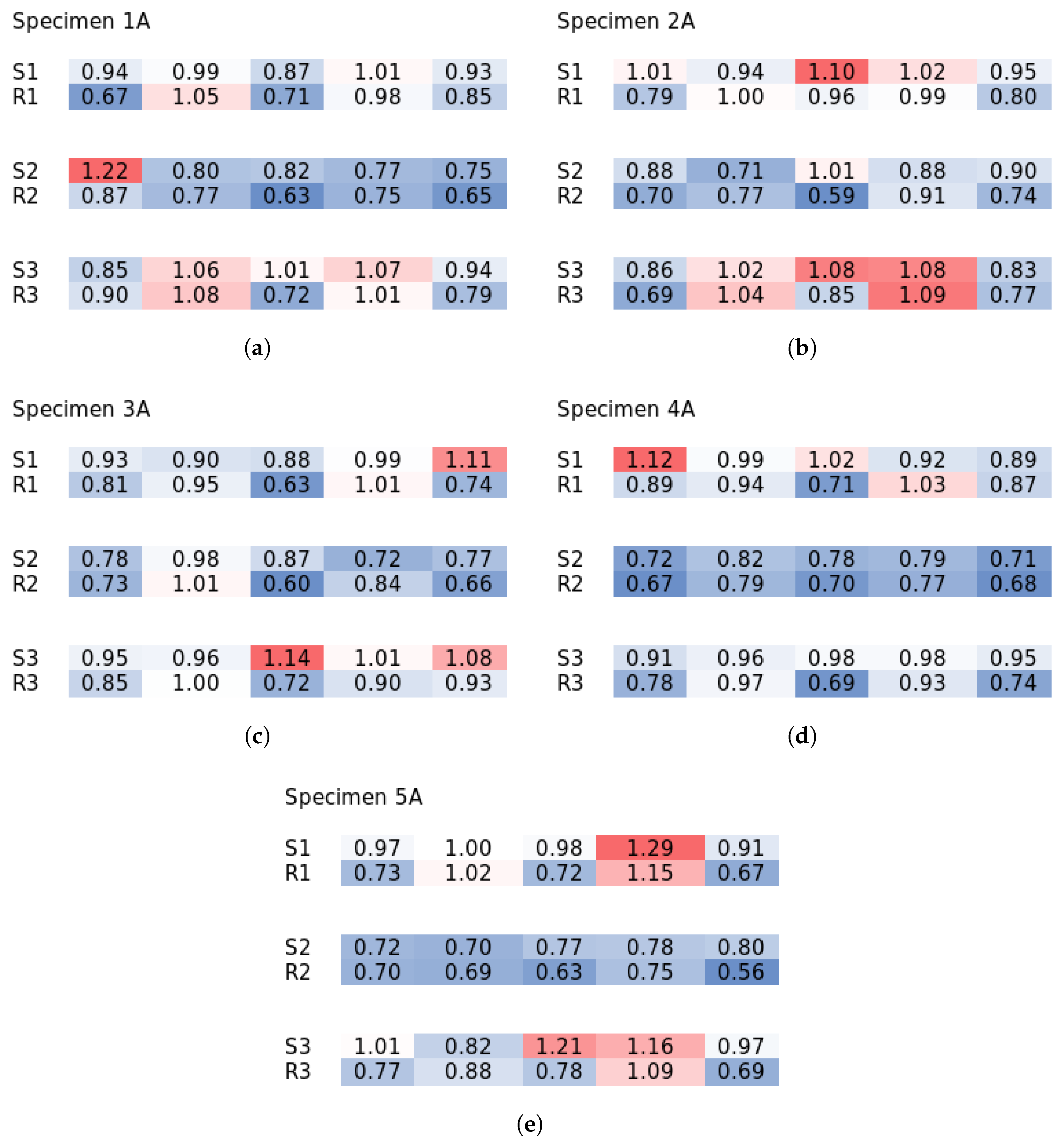
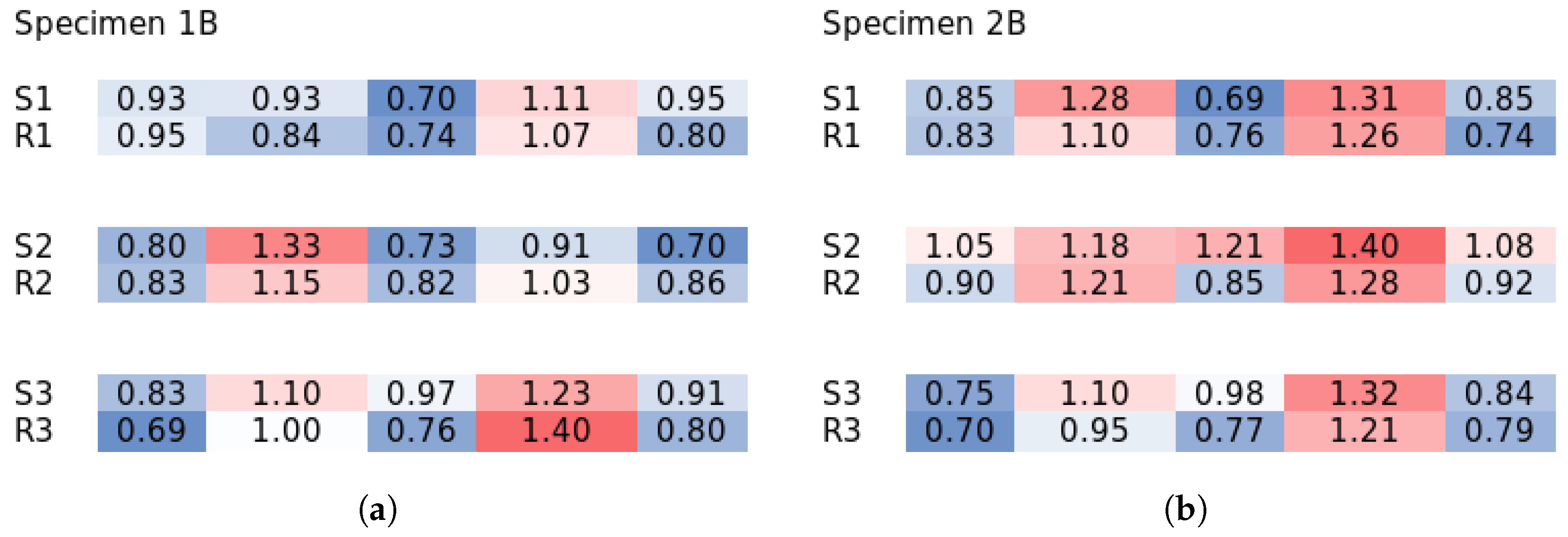
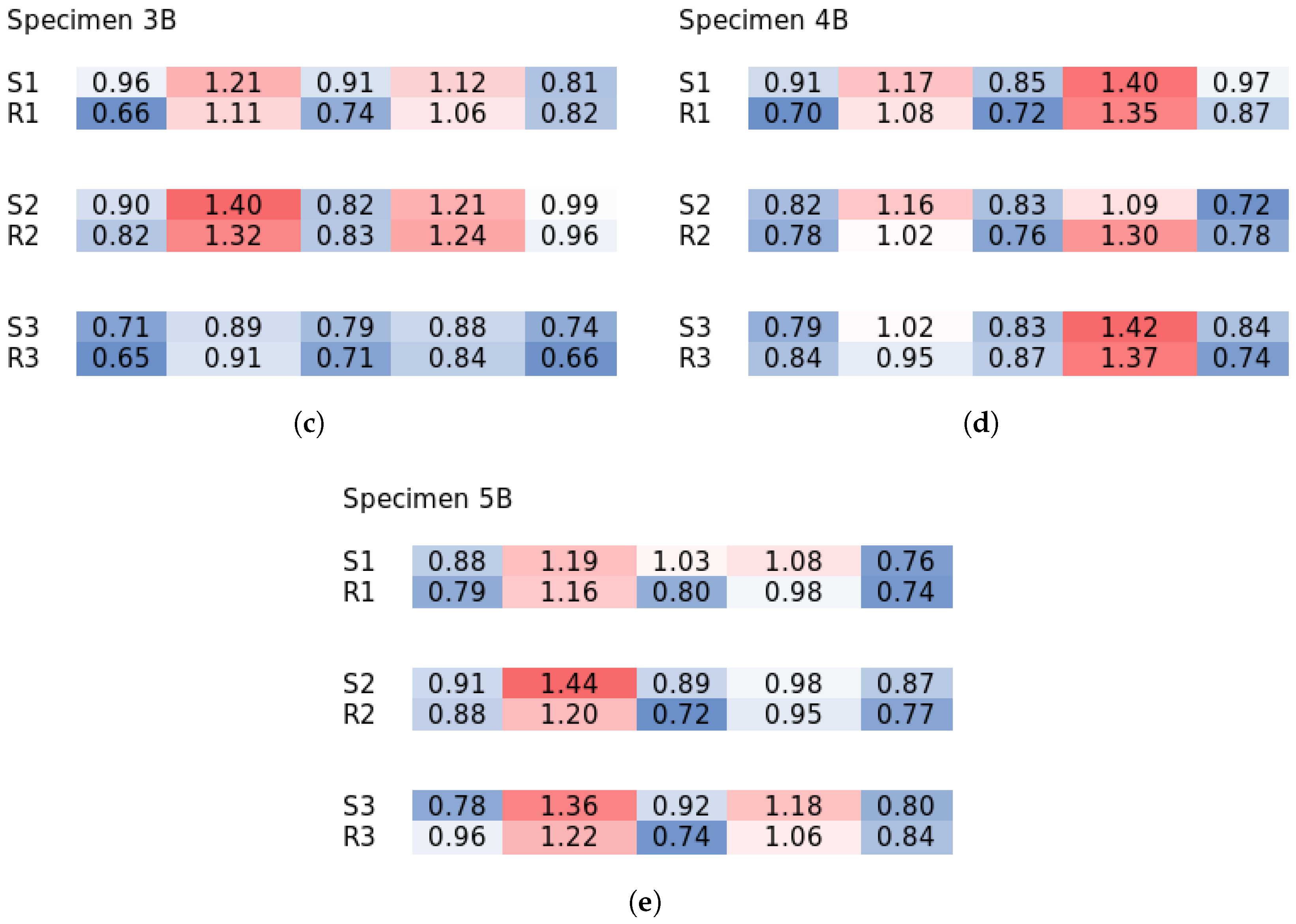
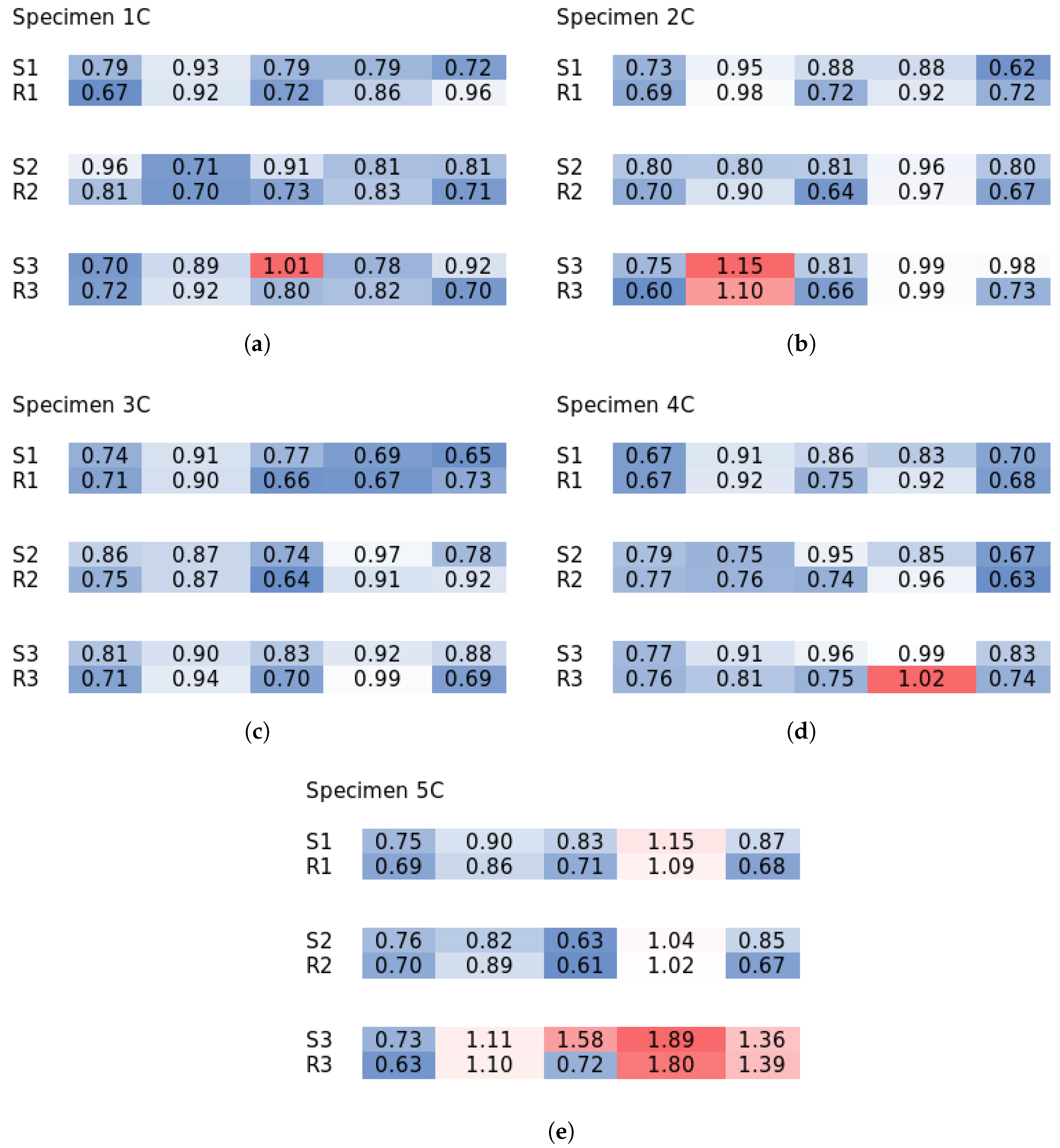
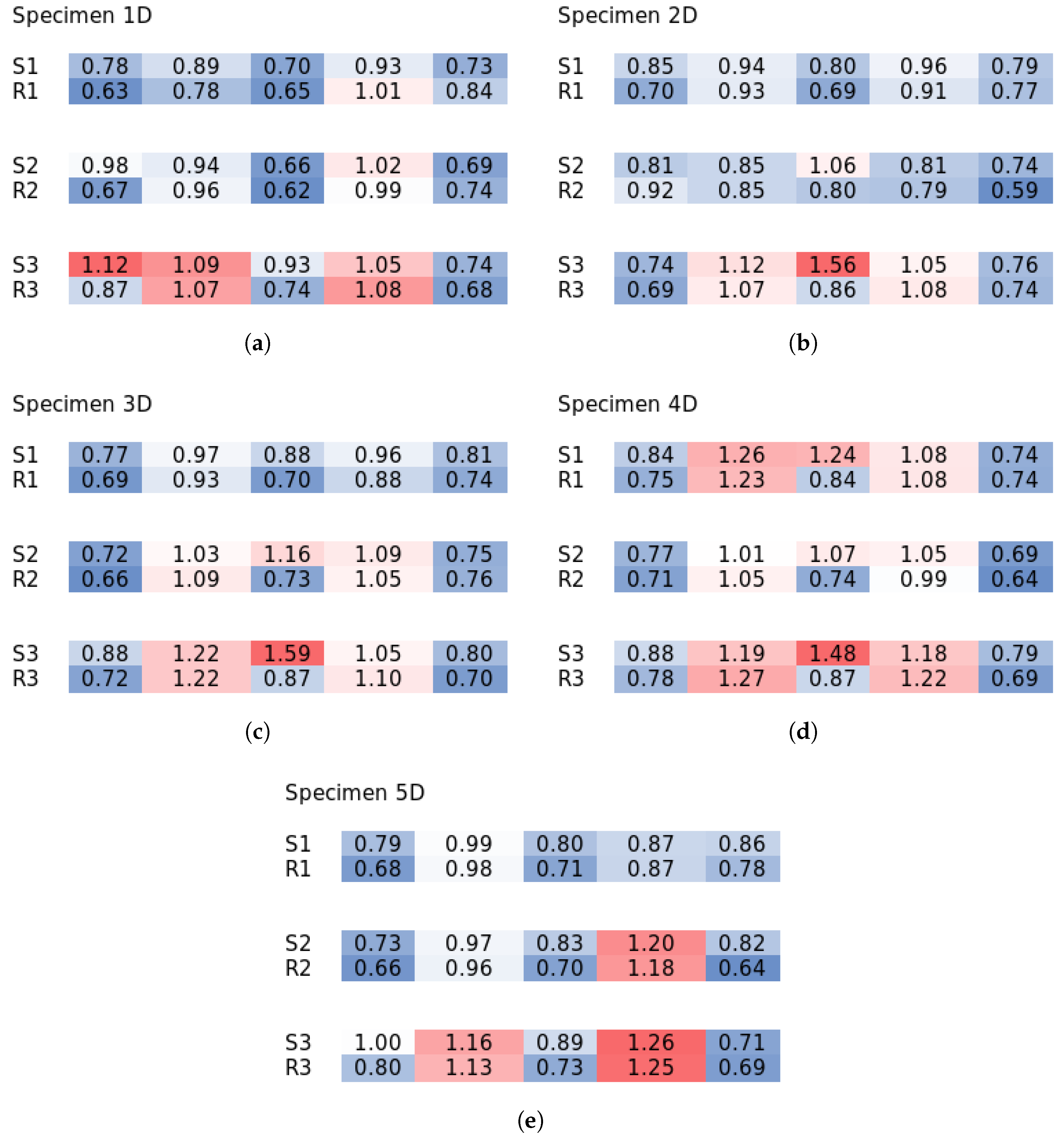
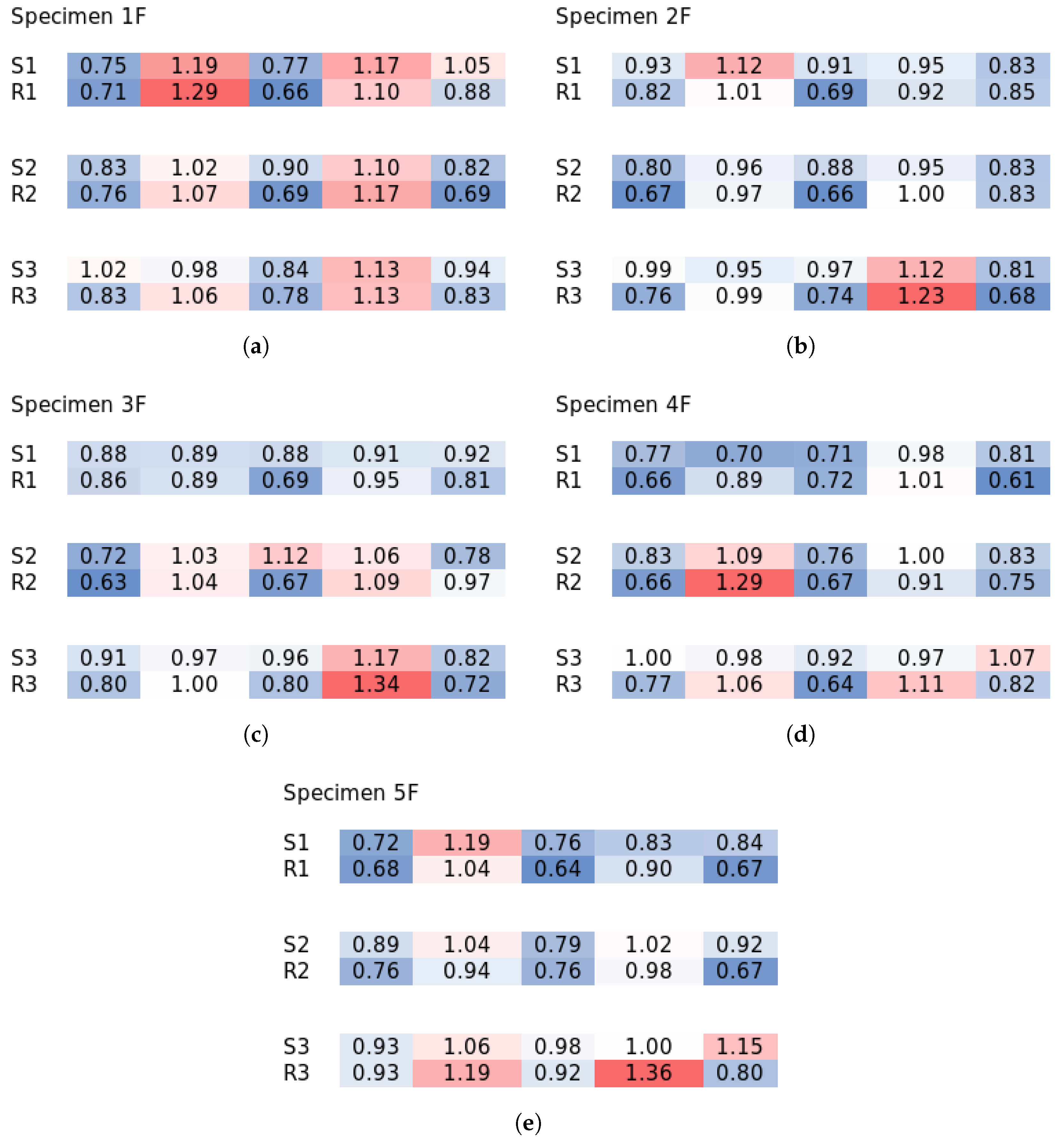
Appendix C
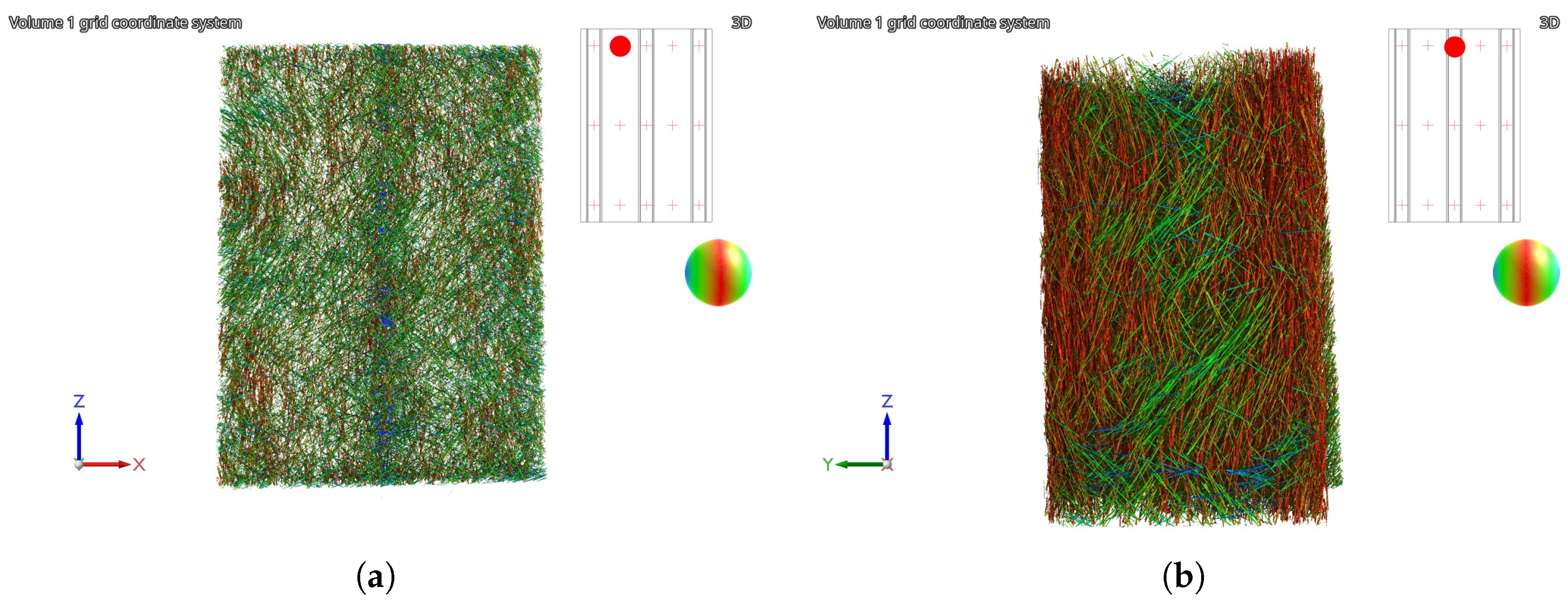
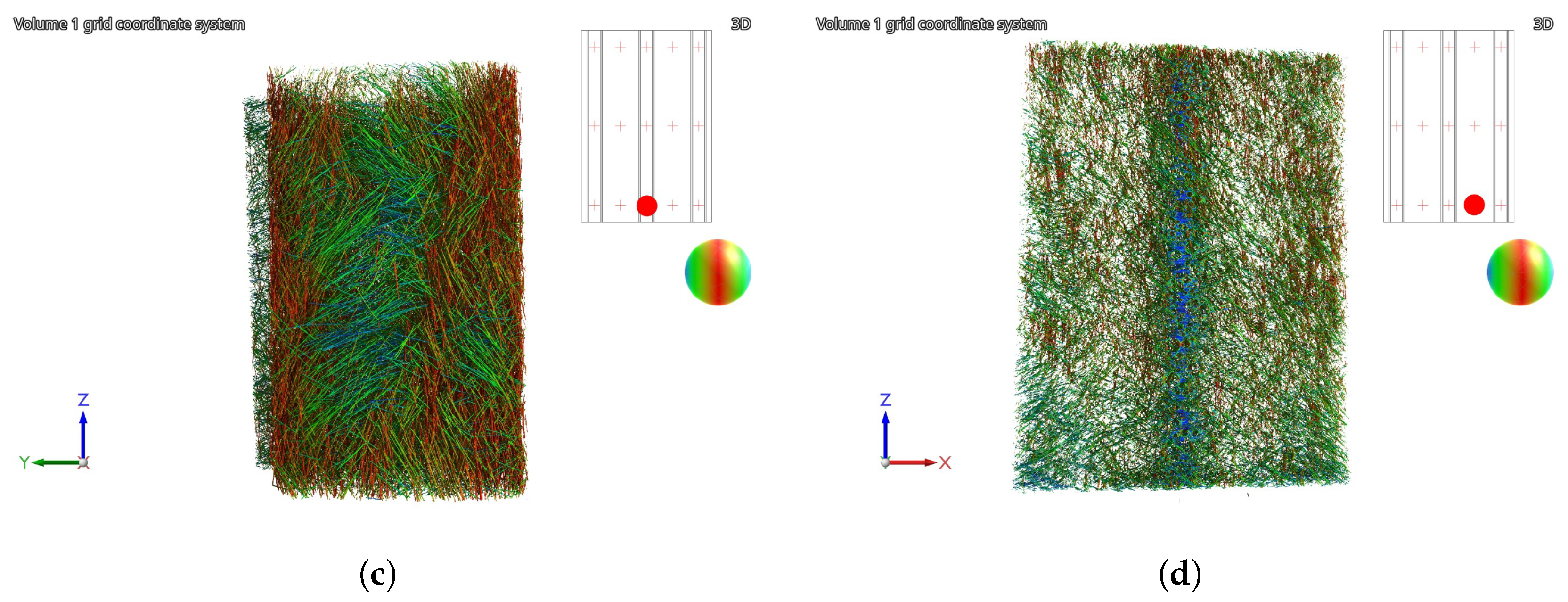
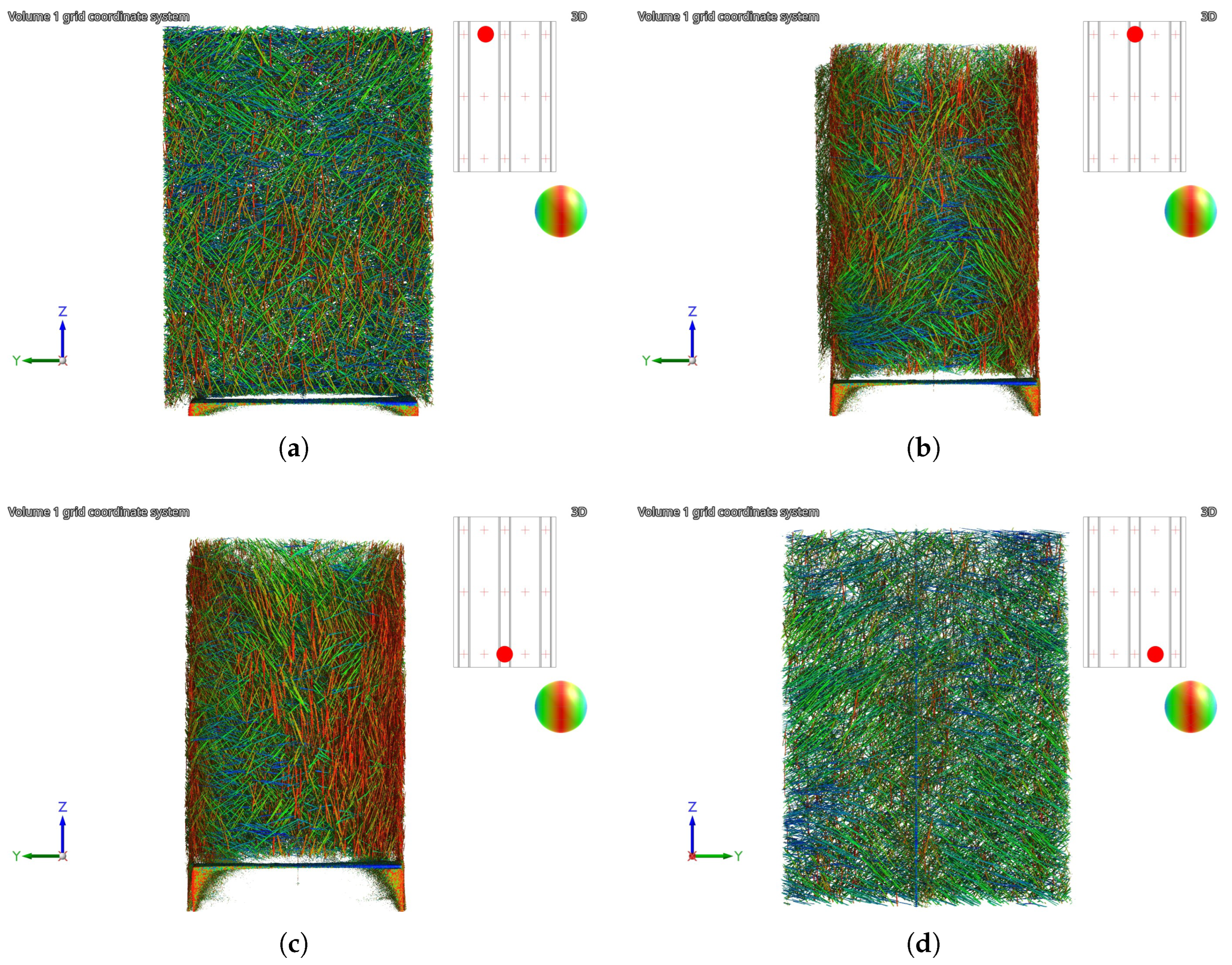
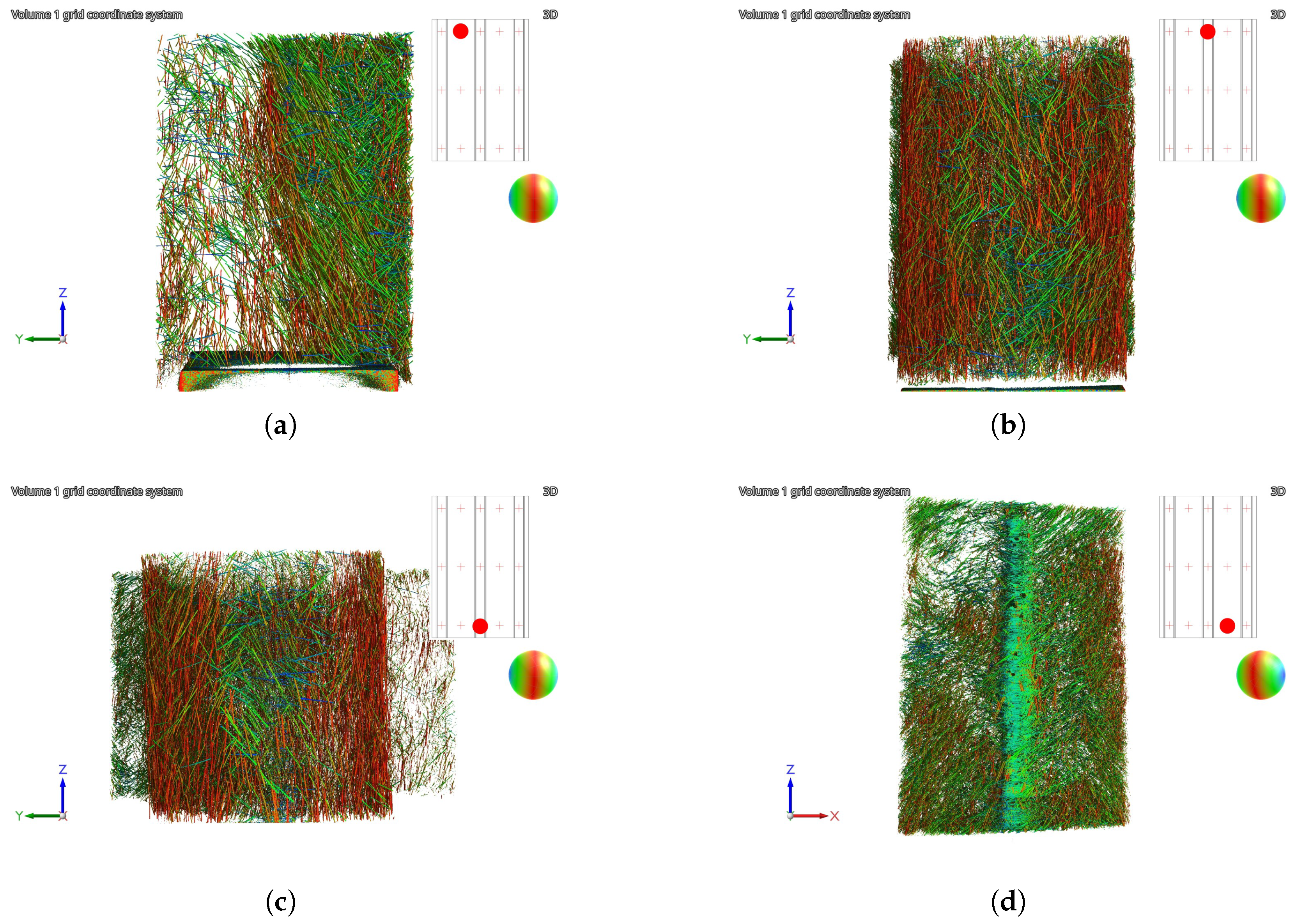
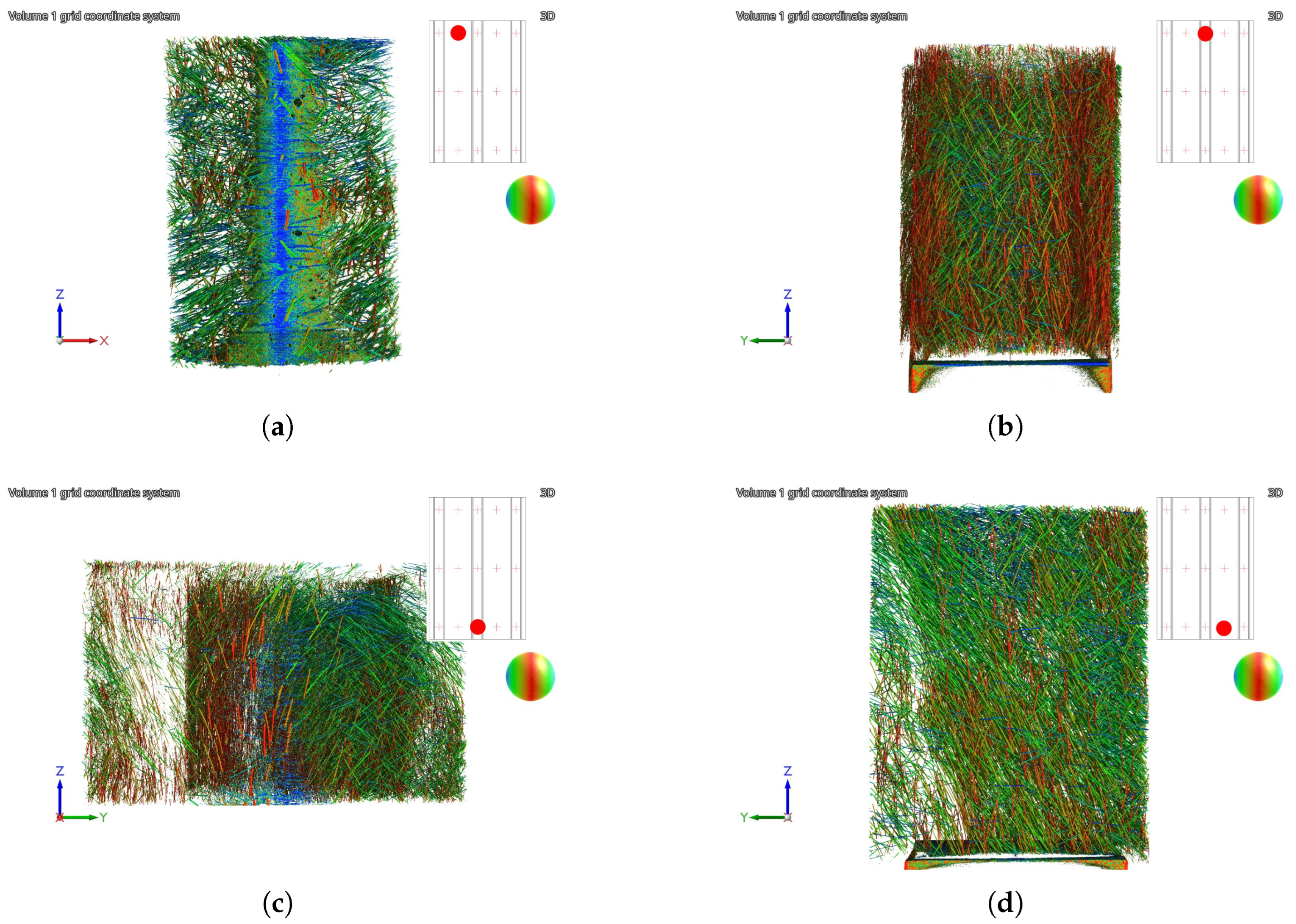
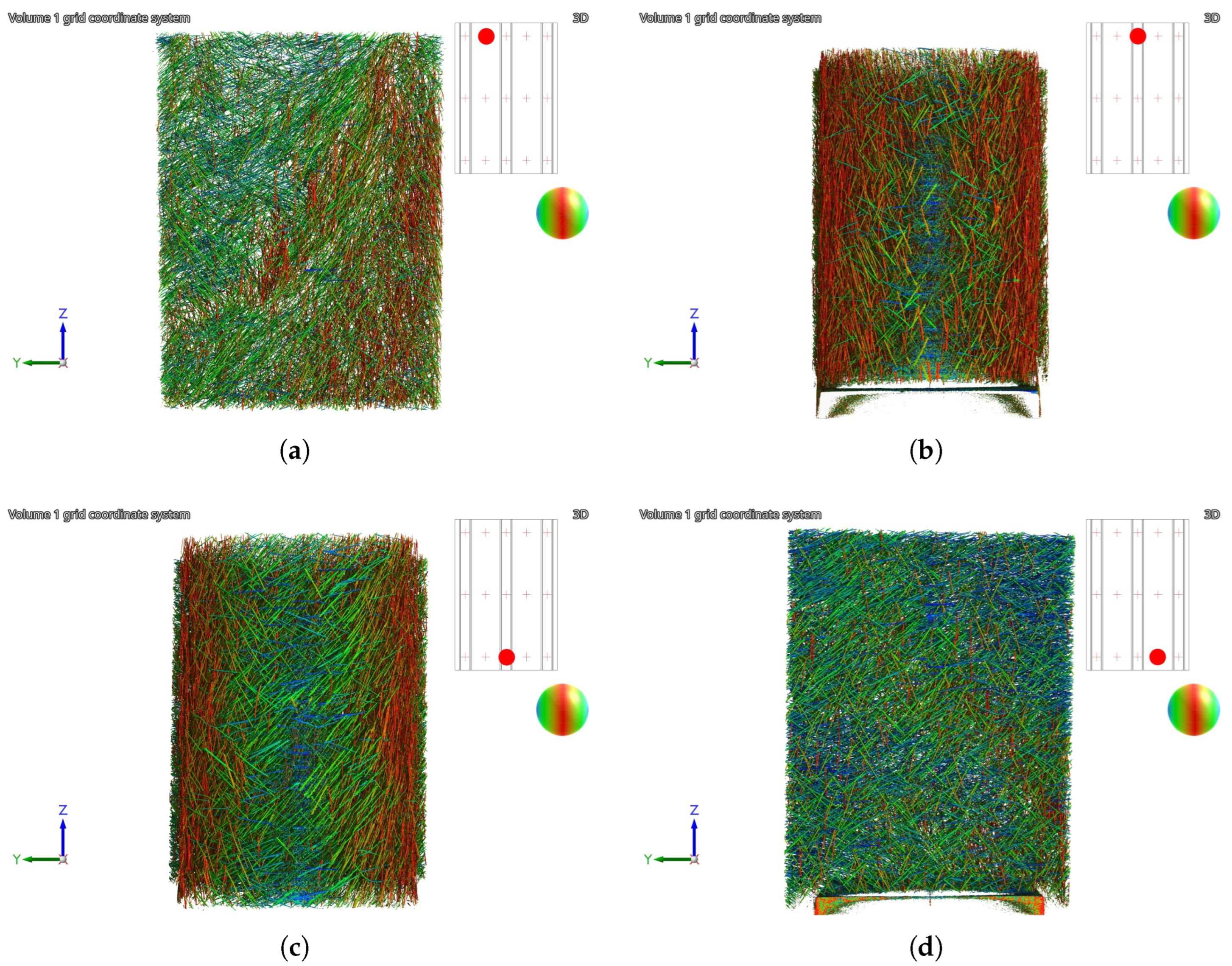
References
- Muthukumarana, T.; Arachchi, M.; Somarathna, H.; Raman, S. A review on the variation of mechanical properties of carbon fibre-reinforced concrete. Constr. Build. Mater. 2023, 366, 130173. [Google Scholar] [CrossRef]
- Shaikh, F.U.A.; Luhar, S.; Şahan Arel, H.; Luhar, I. Performance evaluation of Ultrahigh performance fibre reinforced concrete—A review. Constr. Build. Mater. 2020, 232, 117152. [Google Scholar] [CrossRef]
- Shah, A.A.; Ribakov, Y. Recent trends in steel fibered high-strength concrete. Mater. Des. 2011, 32, 4122–4151. [Google Scholar] [CrossRef]
- Hait, P.; Karthik, R.; Mitra, R.; Haldar, R. Natural and Artificial Fibre Reinforced Concrete: A State-of-art Review. Int. J. Eng. Trans. C Asp. 2024, 37, 503–510. [Google Scholar] [CrossRef]
- Bentur, A.; Mindess, S. Fibre Reinforced Cementitious Composites, 2nd ed.; Modern Concrete Technology; CRC Press/Routledge: Boca Raton, FL, USA, 2019. [Google Scholar]
- Zhao, Y.; Bi, J.; Wang, Z.; Huo, L.; Guan, J.; Zhao, Y.; Sun, Y. Numerical simulation of the casting process of steel fiber reinforced self-compacting concrete: Influence of material and casting parameters on fiber orientation and distribution. Constr. Build. Mater. 2021, 312, 125337. [Google Scholar] [CrossRef]
- Ďubek, M.; Makýš, P.; Petro, M.; Ellingerová, H.; Antošová, N. The Development of Controlled Orientation of Fibres in SFRC. Materials 2021, 14, 4432. [Google Scholar] [CrossRef]
- Xiong, Y.; Yang, M.; Yuan, Y.; Liu, Y.; Zhao, J.; Shi, H. Anisotropic behavior in the flexural properties of aligned steel fiber UHPC produced by electromagnetic field. J. Build. Eng. 2024, 94, 109854. [Google Scholar] [CrossRef]
- Du, W.; Yu, F.; Qiu, L.; Guo, Y.; Wang, J.; Han, B. Effect of Steel Fibers on Tensile Properties of Ultra-High-Performance Concrete: A Review. Materials 2024, 17, 1108. [Google Scholar] [CrossRef] [PubMed]
- Lifshitz Sherzer, G.; Ribakov, Y. Modeling Complex Material Interactions to Replicate and Uncover Mechanisms Driving the Performance of Steel Fiber-Reinforced Concrete Cylinders. Appl. Sci. 2025, 15, 3445. [Google Scholar] [CrossRef]
- Hiew, S.Y.; Teoh, K.B.; Raman, S.N.; Hung, C.C.; Yoo, D.Y.; Wen, K.W.; Kong, D.; Voo, Y.L. 3D micro-CT driven fibre orientation–confinement correlation model for ultra-high-performance concrete (UHPC). Cem. Concr. Compos. 2025, 161, 106081. [Google Scholar] [CrossRef]
- Yuan, H.; Dong, E.; Jia, Z.; Jia, L.; Quan, S.; Ma, M.; Yang, Y.; Feng, M.; Banthia, N.; Zhang, Y. The influence of pore structure and fiber orientation on anisotropic mechanical property of 3D printed ultra-high-performance concrete. Constr. Build. Mater. 2025, 471, 140760. [Google Scholar] [CrossRef]
- Medeghini, F.; Tiberti, G.; Guhathakurta, J.; Simon, S.; Plizzari, G.A.; Mark, P. Fiber orientation and orientation factors in steel fiber-reinforced concrete beams with hybrid fibers: A critical review. Struct. Concr. 2025, 26, 481–500. [Google Scholar] [CrossRef]
- Huang, H.; Teng, L.; Khayat, K.H.; Gao, X.; Wang, F.; Liu, Z. For the improvement of mechanical and microstructural properties of UHPC with fiber alignment using carbon nanotube and graphite nanoplatelet. Cem. Concr. Compos. 2022, 129, 104462. [Google Scholar] [CrossRef]
- Heck, L.; Leutbecher, T. 3D-characterization of fibers in UHPFRC by computed tomography and photography. Constr. Build. Mater. 2025, 483, 141659. [Google Scholar] [CrossRef]
- Ozyurt, N.; Mason, T.O.; Shah, S.P. Non-destructive monitoring of fiber orientation using AC-IS: An industrial-scale application. Cem. Concr. Res. 2006, 36, 1653–1660. [Google Scholar] [CrossRef]
- Ozyurt, N.; Woo, L.Y.; Mason, T.O.; Shah, S.P. Monitoring fiber dispersion in fiber-reinforced cementitious materials: Comparison of AC-impedance spectroscopy and image analysis. ACI Mater. J. 2006, 103, 340–347. [Google Scholar] [CrossRef]
- Chung, K.L.; Wang, L.; Ghannam, M.; Guan, M.; Luo, J. Prediction of concrete compressive strength based on early-age effective conductivity measurement. J. Build. Eng. 2021, 35, 101998. [Google Scholar] [CrossRef]
- Damme, S.V.; Franchois, A.; Zutter, D.D.; Taerwe, L. Nondestructive determination of the steel fiber content in concrete slabs with an open-ended coaxial probe. IEEE Trans. Geosci. Remote Sens. 2004, 42, 2511–2521. [Google Scholar] [CrossRef]
- Kruschwitz, S.; Oesch, T.; Mielentz, F.; Meinel, D.; Spyridis, P. Non-Destructive Multi-Method Assessment of Steel Fiber Orientation in Concrete. Appl. Sci. 2022, 12, 697. [Google Scholar] [CrossRef]
- Cavalaro, S.H.P.; López, R.; Torrents, J.M.; Aguado, A. Improved assessment of fibre content and orientation with inductive method in SFRC. Mater. Struct. 2015, 48, 1859–1873. [Google Scholar] [CrossRef]
- Torrents, J.M.; Blanco, A.; Pujadas, P.; Aguado, A.; Juan-García, P.; Sánchez-Moragues, M.A. Inductive method for assessing the amount and orientation of steel fibers in concrete. Mater. Struct. 2012, 45, 1577–1592. [Google Scholar] [CrossRef]
- Faifer, M.; Ferrara, L.; Ottoboni, R.; Toscani, S. Low Frequency Electrical and Magnetic Methods for Non-Destructive Analysis of Fiber Dispersion in Fiber Reinforced Cementitious Composites: An Overview. Sensors 2013, 13, 1300–1318. [Google Scholar] [CrossRef]
- Frankowski, P.K.; Majzner, P.; Mąka, M.; Stawicki, T. Non-Destructive Evaluation of Reinforced Concrete Structures with Magnetic Flux Leakage and Eddy Current Methods—Comparative Analysis. Appl. Sci. 2024, 14, 11965. [Google Scholar] [CrossRef]
- Kobaka, J.; Katzer, J.; Ponikiewski, T. A Combined Electromagnetic Induction and Radar-Based Test for Quality Control of Steel Fibre Reinforced Concrete. Materials 2019, 12, 3507. [Google Scholar] [CrossRef]
- Zhang, S.; Liao, L.; Song, S.; Zhang, C. Experimental and analytical study of the fibre distribution in SFRC: A comparison between image processing and the inductive test. Compos. Struct. 2018, 188, 78–88. [Google Scholar] [CrossRef]
- Abedi, M.; Rojas, G.; Domingo, M.; Martius-Hammer, T.A.; Kanstad, T.; Ji, G. Steel fiber distribution and orientation in full-scale walls cast from FRC with various consistencies and casting procedures: Evaluation by the inductive method. Mater. Struct. 2025, 58, 81. [Google Scholar] [CrossRef]
- Shi, J.H.; Xia, J.; Wu, R.J.; Chen, K.Y.; Wang, J.; Hoo, Y.Y. Non-destructive testing method of fiber content in steel fiber reinforced concrete based on magnetization loss. J. Magn. Magn. Mater. 2023, 586, 171205. [Google Scholar] [CrossRef]
- Rojas, G.; Mena-Alonso, Á.; Muñoz, Á.; Kanstad, T.; Vicente, M.A. Experimental study of the fibre distribution in SFRC: A comparison between CT-scanning techniques and the inductive method. Mater. Struct. 2025, 58, 259. [Google Scholar] [CrossRef]
- Künzel, K.; Papež, V.; Carrera, K.; Konrád, P.; Mára, M.; Kheml, P.; Sovják, R. Electromagnetic Properties of Steel Fibres for Use in Cementitious Composites, Fibre Detection and Non-Destructive Testing. Materials 2021, 14, 2131. [Google Scholar] [CrossRef]
- Ministry of Transport of the Czech Republic. TP 267—Ultra Vysokohodnotný Beton (UHPC); Ministry of Transport of the Czech Republic: Prague, Czech Republic, 2024.
- ČSN EN 206+A2; Concrete—Specification, Performance, Production and Conformity. Czech Office for Standards, Metrology and Testing: Prague, Czech Republic, 2021.
- Carrera, K.; Sovják, R.; Papež, V.; Künzel, K. Quality factor as a tool to measure concentration and orientation of ferromagnetic fibres in sample. Mater. Today Proc. 2022, 62, 2624–2627. [Google Scholar] [CrossRef]
- Papež, V.; Künzel, K.; Konrád, P.; Carrera, K.; Konvalinka, P. Non-destructive diagnostics of fiber orientation in large planar fiber-reinforced concrete specimens. arXiv 2025. [Google Scholar] [CrossRef]
- Nováková, K.; Carrera, K.; Konrád, P.; Künzel, K.; Papež, V.; Sovják, R. Simulations of the Behaviour of Steel Ferromagnetic Fibres Commonly Used in Concrete in a Magnetic Field. Materials 2022, 15, 128. [Google Scholar] [CrossRef] [PubMed]
- Boulekbache, B.; Hamrat, M.; Chemrouk, M.; Amziane, S. Flowability of fibre-reinforced concrete and its effect on the mechanical properties of the material. Constr. Build. Mater. 2010, 24, 1664–1671. [Google Scholar] [CrossRef]

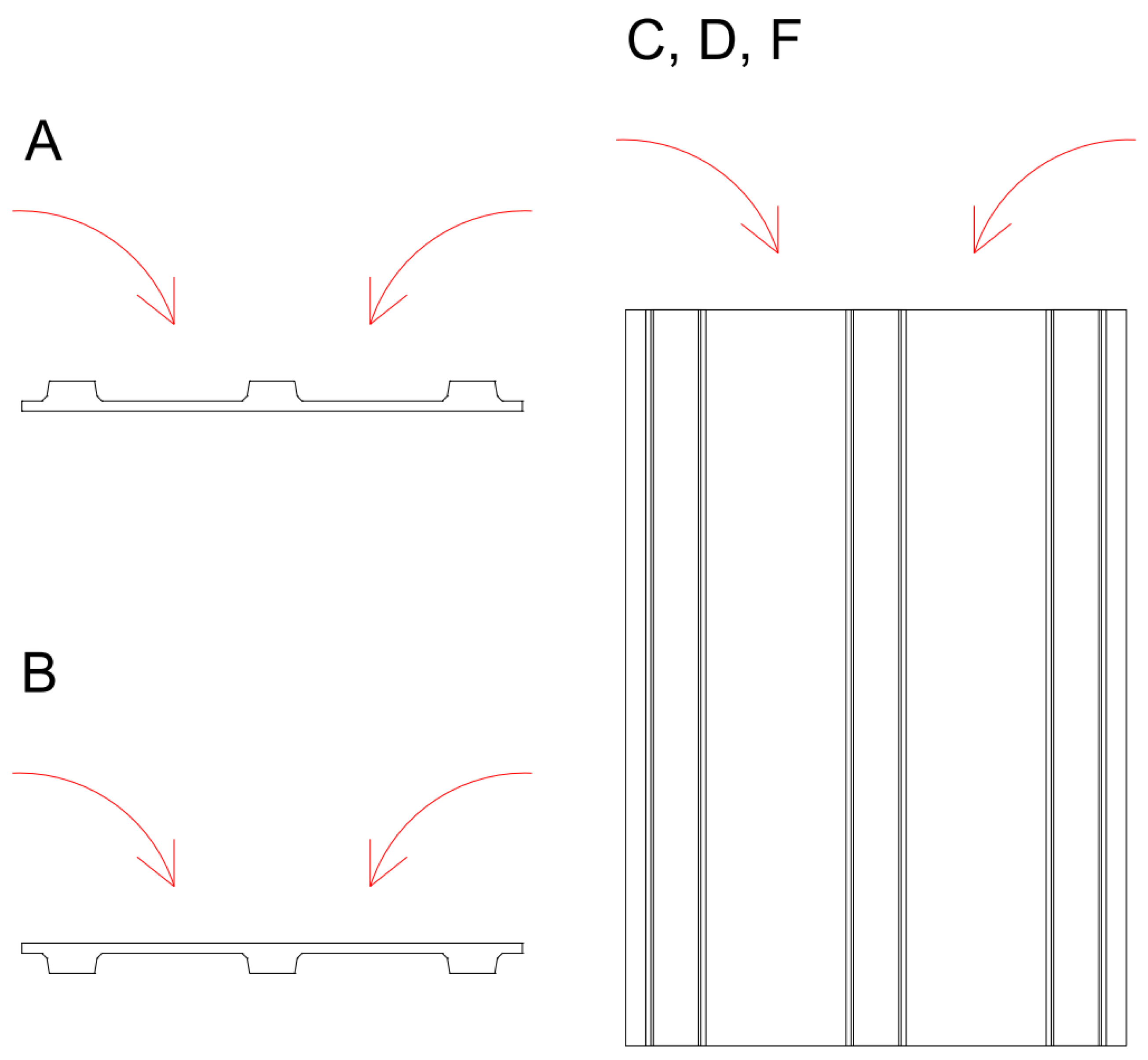
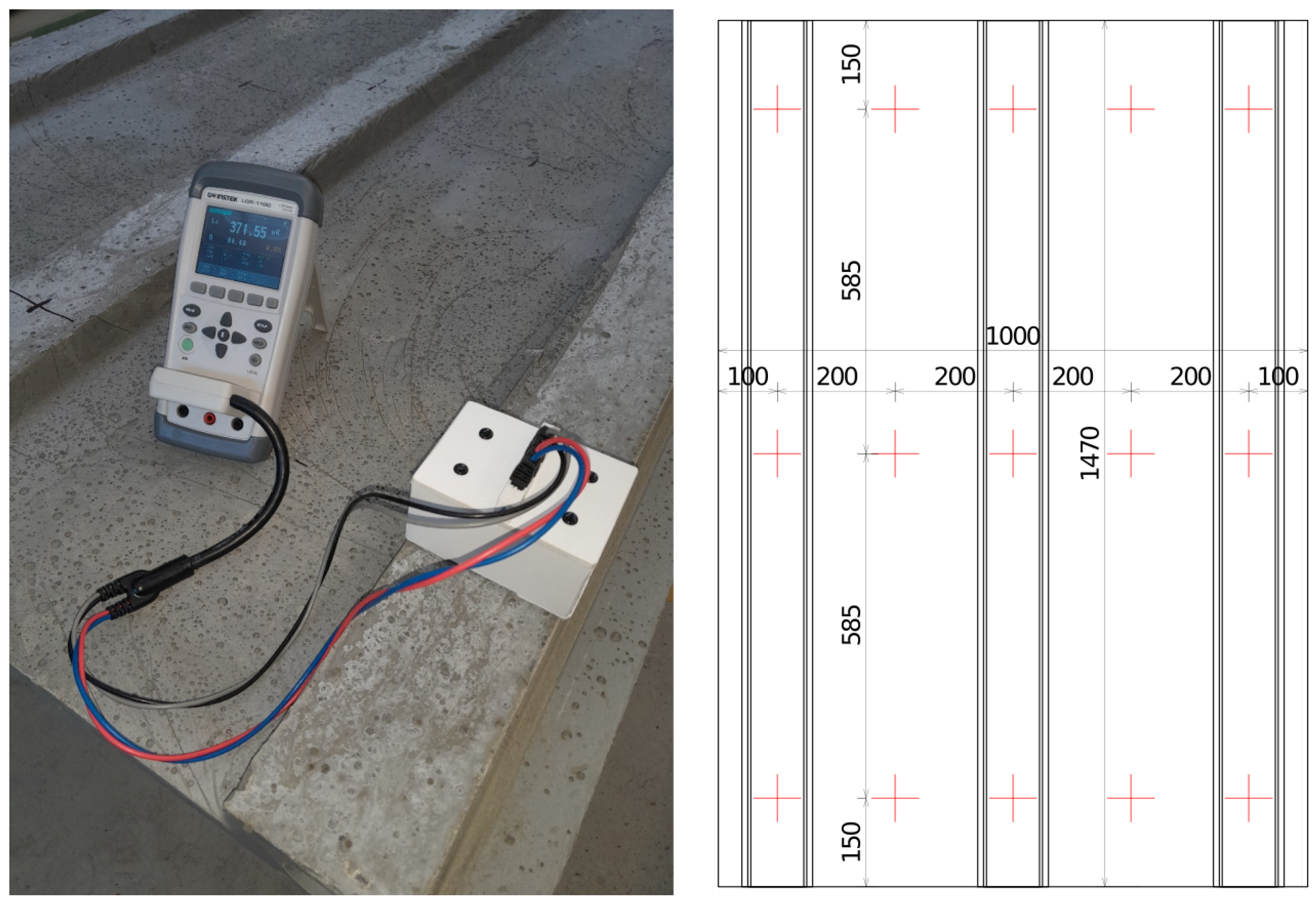
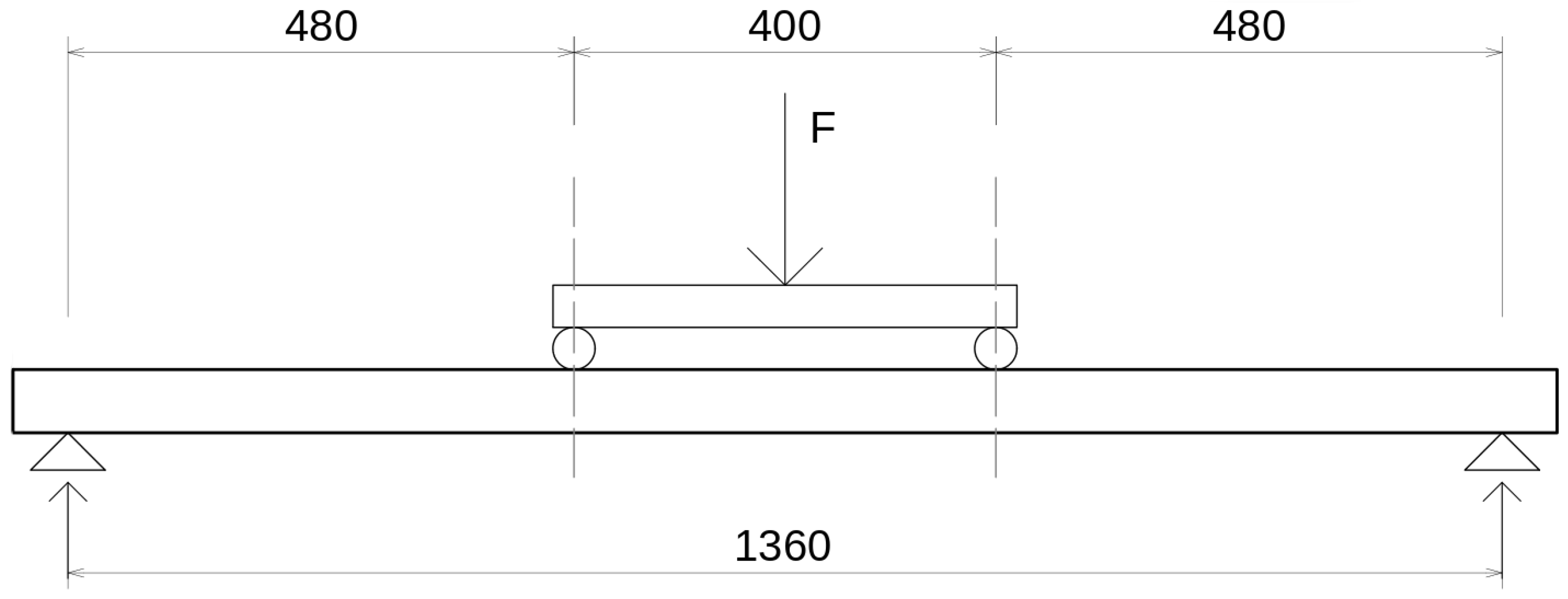
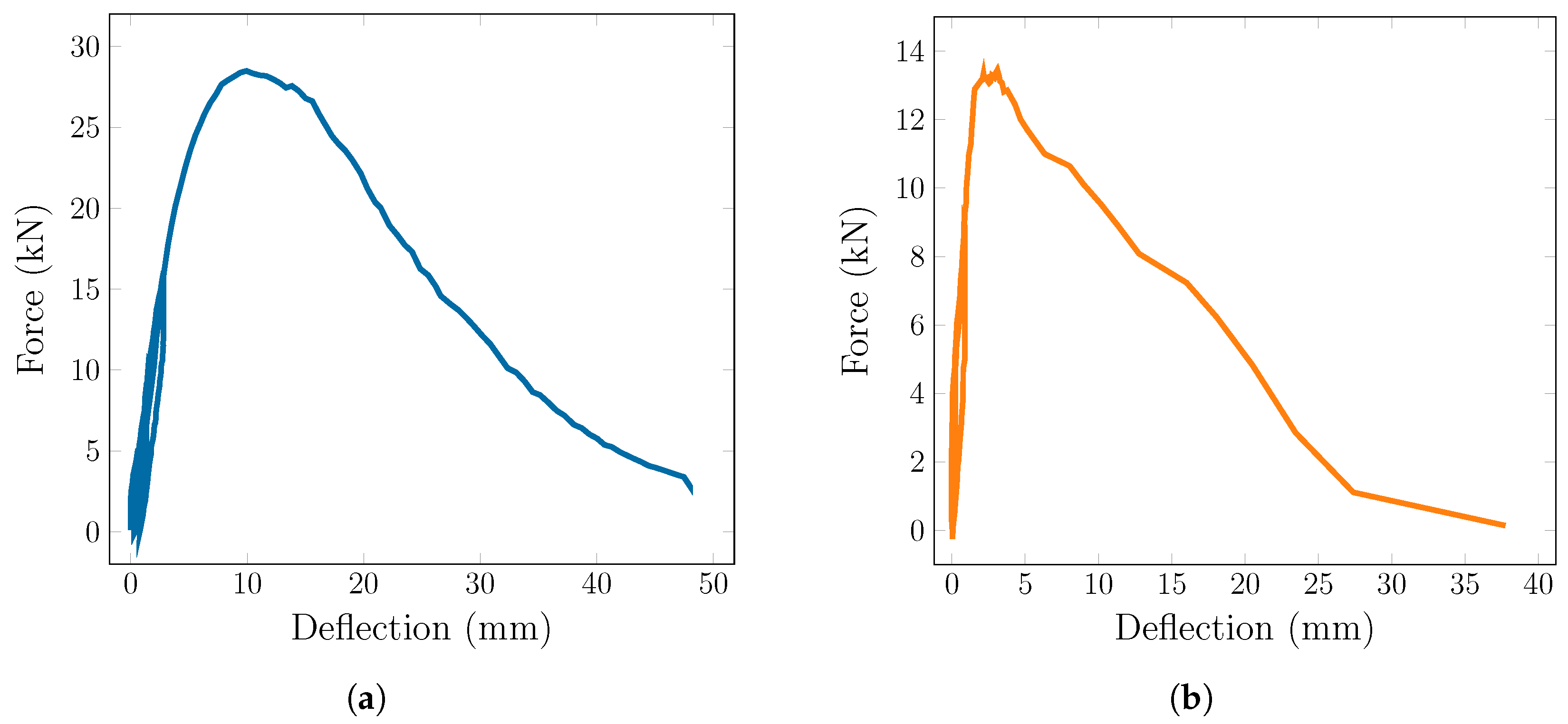
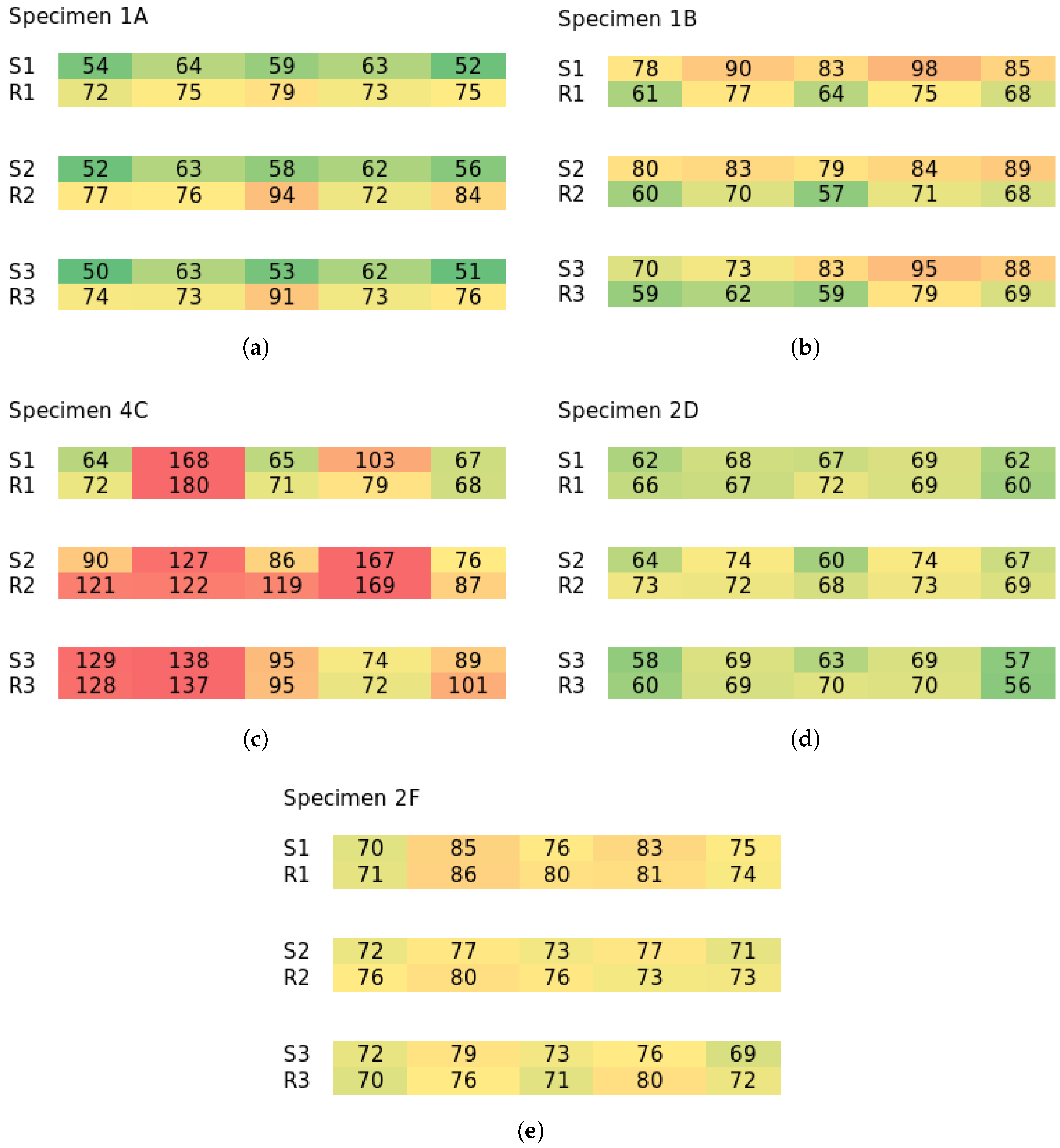
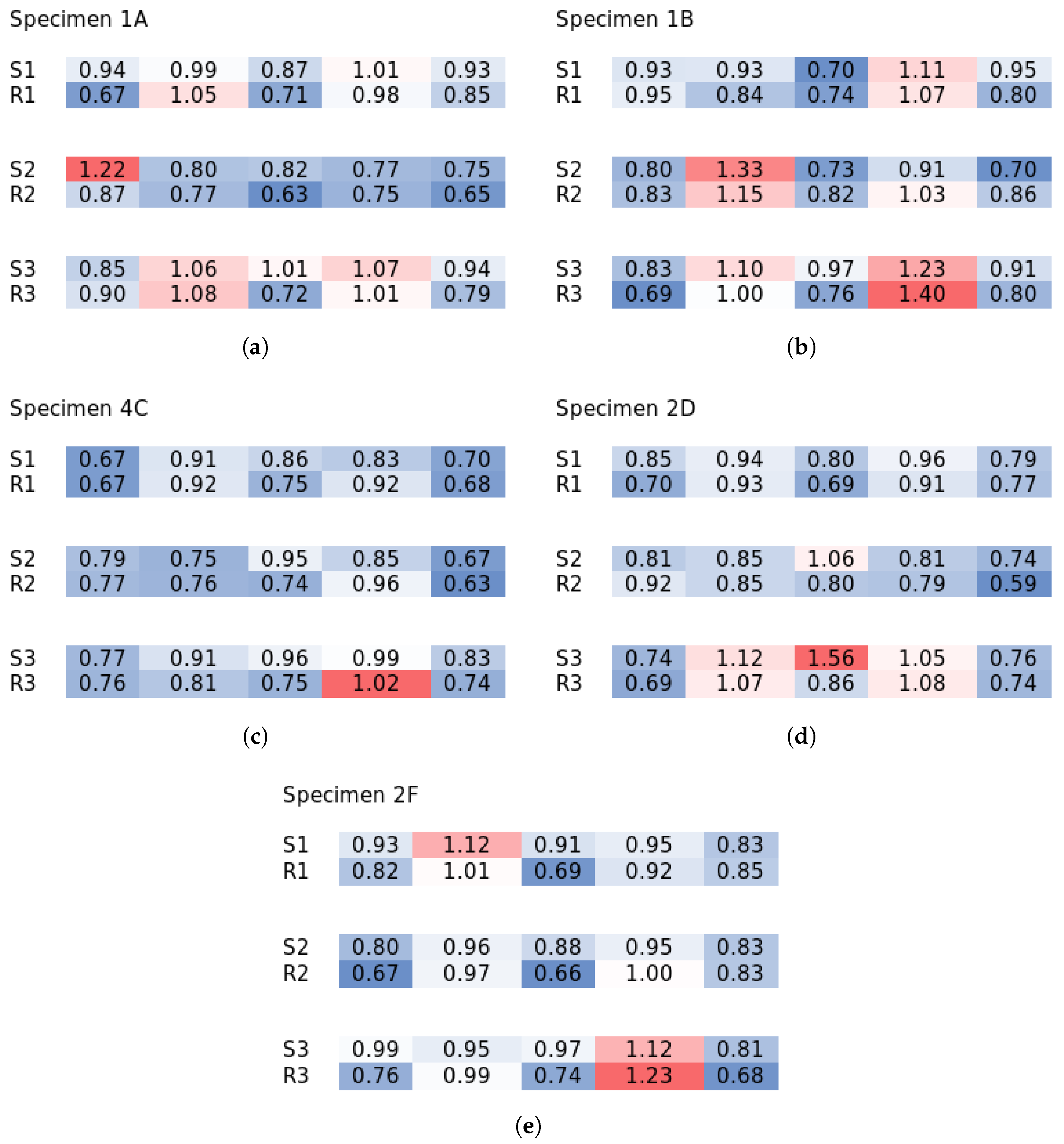

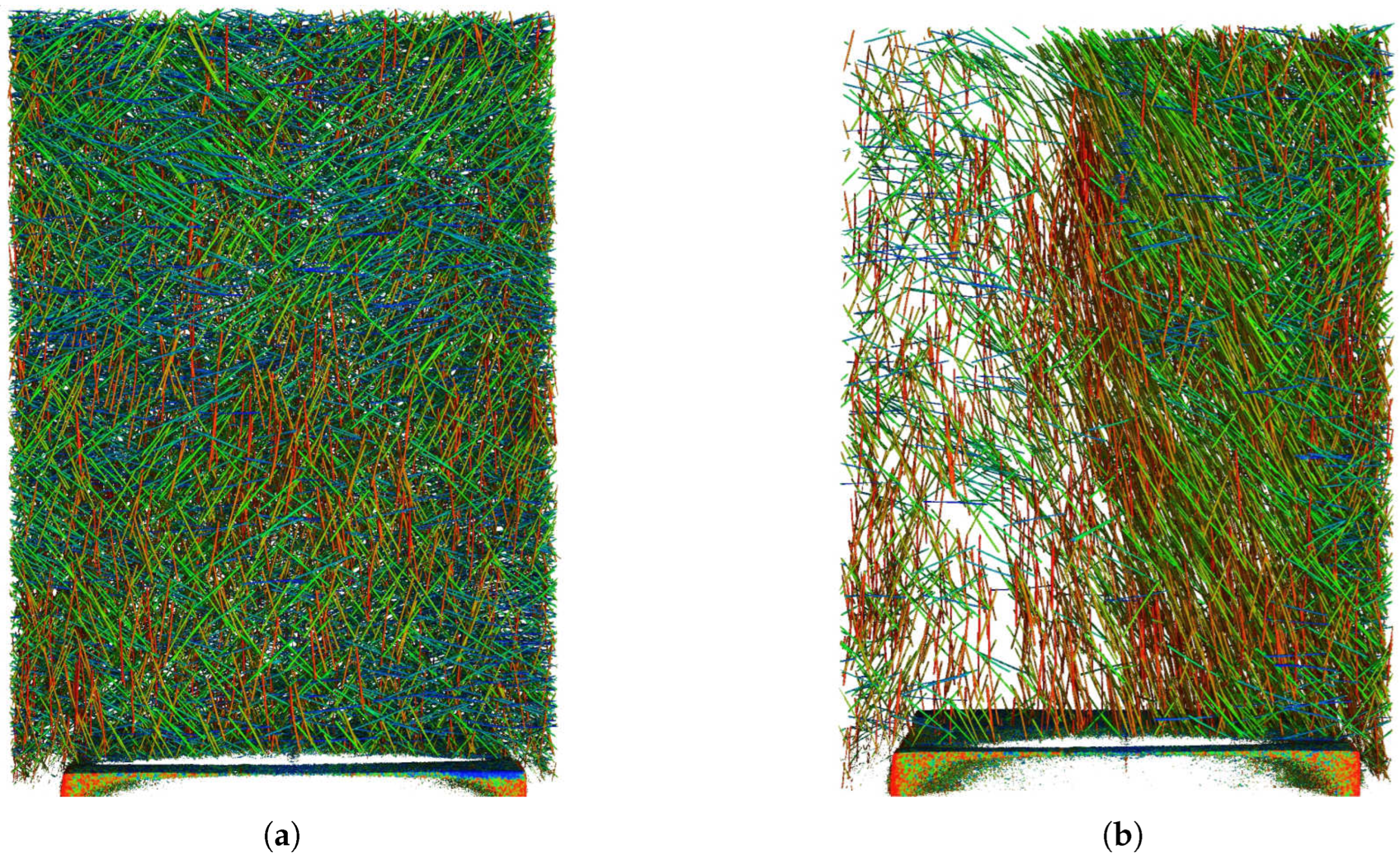
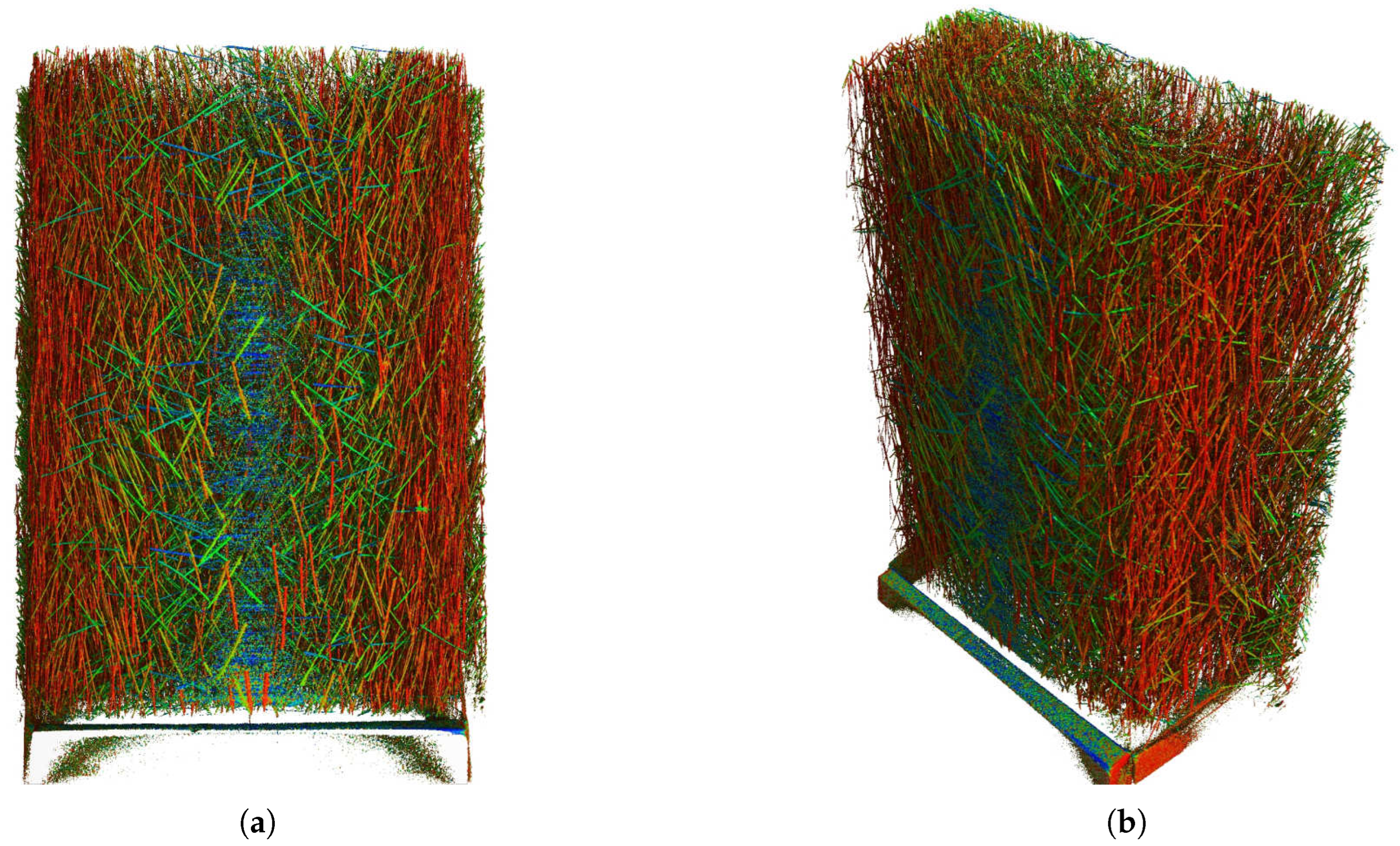
| Constituent | Part |
|---|---|
| Cement | 36% weight |
| Sand 0/2 mm | 59% weight |
| Slag, ash, silica fume | 11.5% weight |
| Admixtures | 3.5% weight |
| Steel fibers | 1.5% volume |
| Specimen | Maximum Force (kN) | Flexural Strength (MPa) | Average Flexural Strength (MPa) |
|---|---|---|---|
| 1A | 28.52 | 31.1 | 34.9 (4.1) |
| 2A | 27.82 | 30.3 | |
| 3A | 32.99 | 36.0 | |
| 4A | 36.67 | 40.0 | |
| 5A | 34.07 | 37.1 | |
| 1B | 20.05 | 21.9 | 22.1 (3.4) |
| 2B | 17.22 | 18.8 | |
| 3B | 17.35 | 18.9 | |
| 4B | 23.28 | 25.4 | |
| 5B | 23.54 | 25.7 | |
| 1C | 18.43 | 20.1 | 17.5 (3.7) |
| 2C | 13.62 | 14.9 | |
| 3C | 13.55 | 14.8 | |
| 4C | 13.95 | 15.2 | |
| 5C | 20.90 | 22.8 | |
| 1D | 27.94 | 30.5 | 31.5 (2.9) |
| 2D | 28.12 | 30.7 | |
| 3D | 33.19 | 36.2 | |
| 4D | 29.09 | 31.7 | |
| 5D | 25.95 | 28.3 | |
| 1F | 31.49 | 34.3 | 33.4 (5.5) |
| 2F | 34.48 | 37.6 | |
| 3F | 35.71 | 38.9 | |
| 4F | 27.97 | 30.5 | |
| 5F | 23.36 | 25.5 |
Disclaimer/Publisher’s Note: The statements, opinions and data contained in all publications are solely those of the individual author(s) and contributor(s) and not of MDPI and/or the editor(s). MDPI and/or the editor(s) disclaim responsibility for any injury to people or property resulting from any ideas, methods, instructions or products referred to in the content. |
© 2025 by the authors. Licensee MDPI, Basel, Switzerland. This article is an open access article distributed under the terms and conditions of the Creative Commons Attribution (CC BY) license (https://creativecommons.org/licenses/by/4.0/).
Share and Cite
Konrád, P.; Künzel, K.; Kheml, P.; Mára, M.; Carrera, K.; Beránek, L.; Hlavůňková, L.; Fornůsek, J.; Konvalinka, P.; Sovják, R. Analysis of Fiber Content and Orientation in Prefabricated Slab Elements Made of UHPFRC: Non-Destructive, Destructive, and CT Scanning Methods. Materials 2025, 18, 4843. https://doi.org/10.3390/ma18214843
Konrád P, Künzel K, Kheml P, Mára M, Carrera K, Beránek L, Hlavůňková L, Fornůsek J, Konvalinka P, Sovják R. Analysis of Fiber Content and Orientation in Prefabricated Slab Elements Made of UHPFRC: Non-Destructive, Destructive, and CT Scanning Methods. Materials. 2025; 18(21):4843. https://doi.org/10.3390/ma18214843
Chicago/Turabian StyleKonrád, Petr, Karel Künzel, Přemysl Kheml, Michal Mára, Kristýna Carrera, Libor Beránek, Lucie Hlavůňková, Jindřich Fornůsek, Petr Konvalinka, and Radoslav Sovják. 2025. "Analysis of Fiber Content and Orientation in Prefabricated Slab Elements Made of UHPFRC: Non-Destructive, Destructive, and CT Scanning Methods" Materials 18, no. 21: 4843. https://doi.org/10.3390/ma18214843
APA StyleKonrád, P., Künzel, K., Kheml, P., Mára, M., Carrera, K., Beránek, L., Hlavůňková, L., Fornůsek, J., Konvalinka, P., & Sovják, R. (2025). Analysis of Fiber Content and Orientation in Prefabricated Slab Elements Made of UHPFRC: Non-Destructive, Destructive, and CT Scanning Methods. Materials, 18(21), 4843. https://doi.org/10.3390/ma18214843








